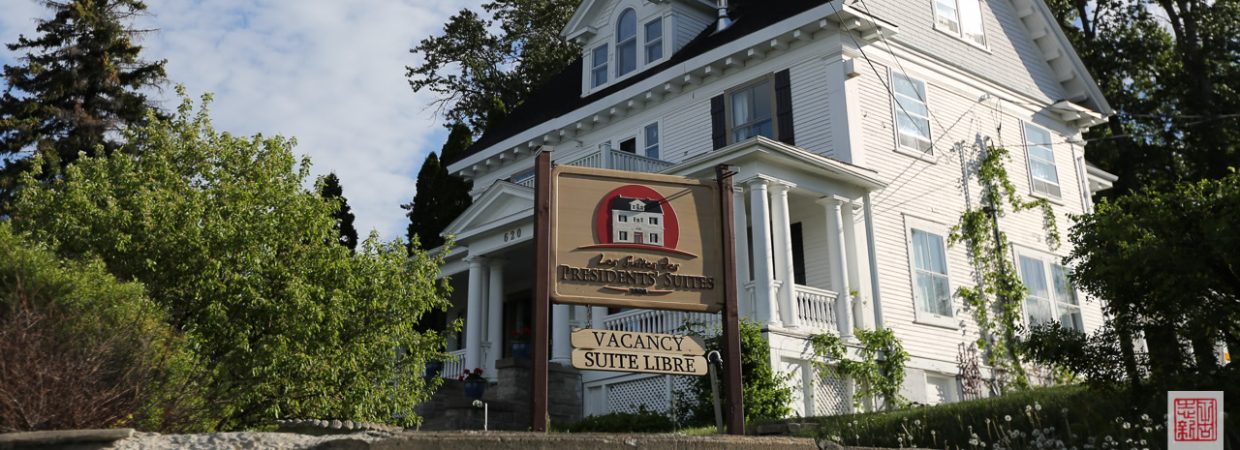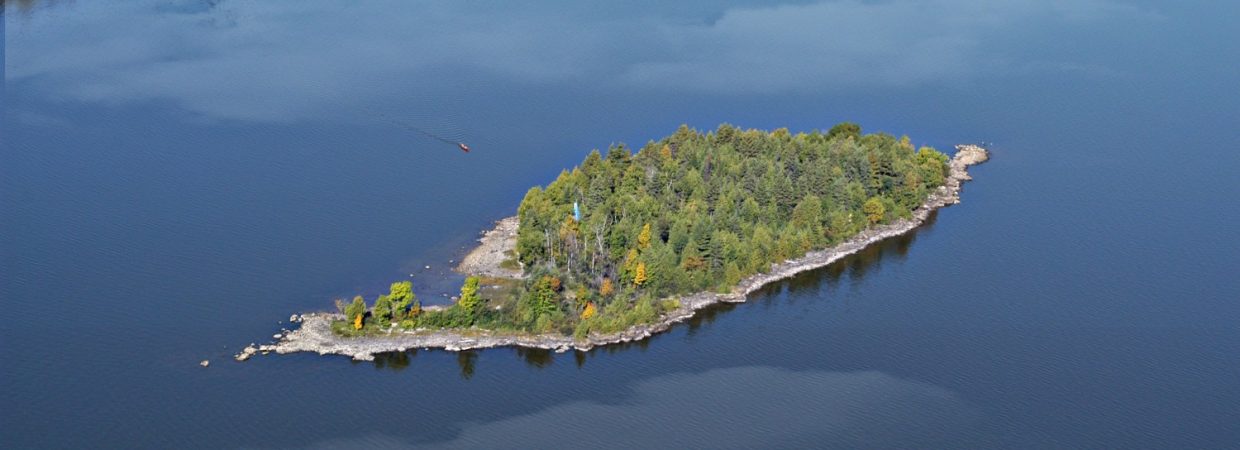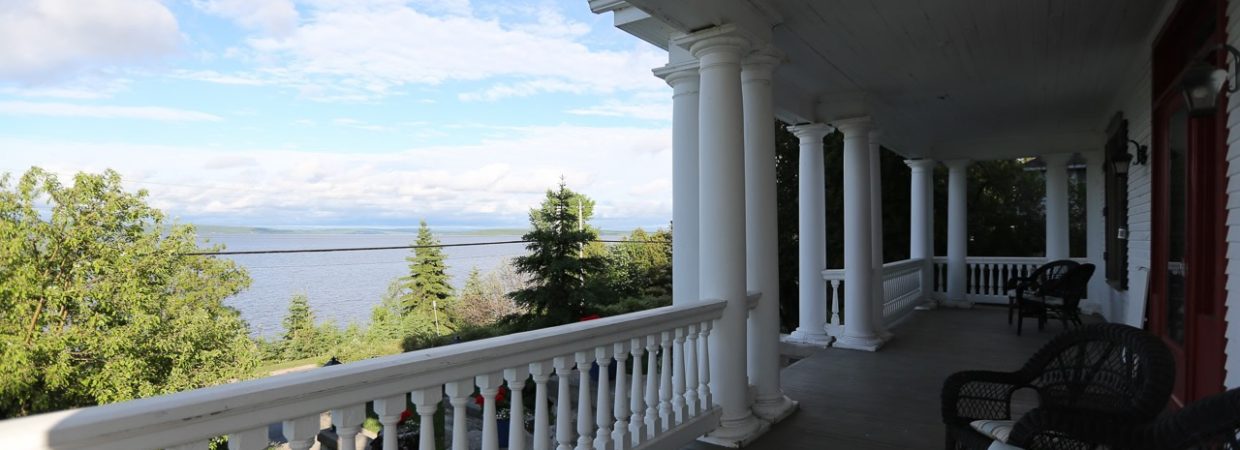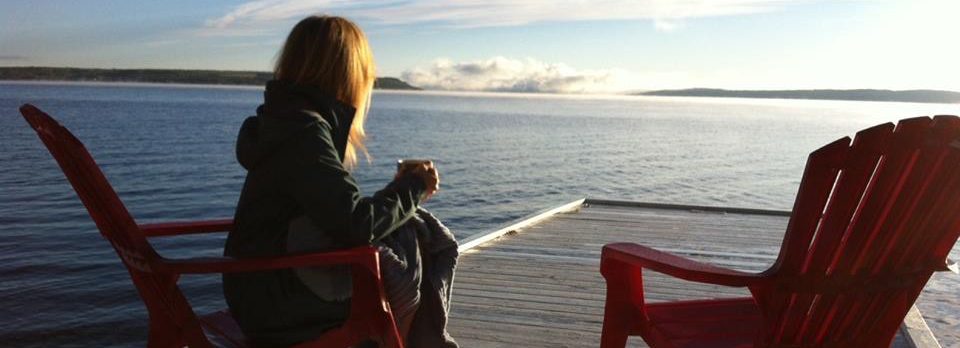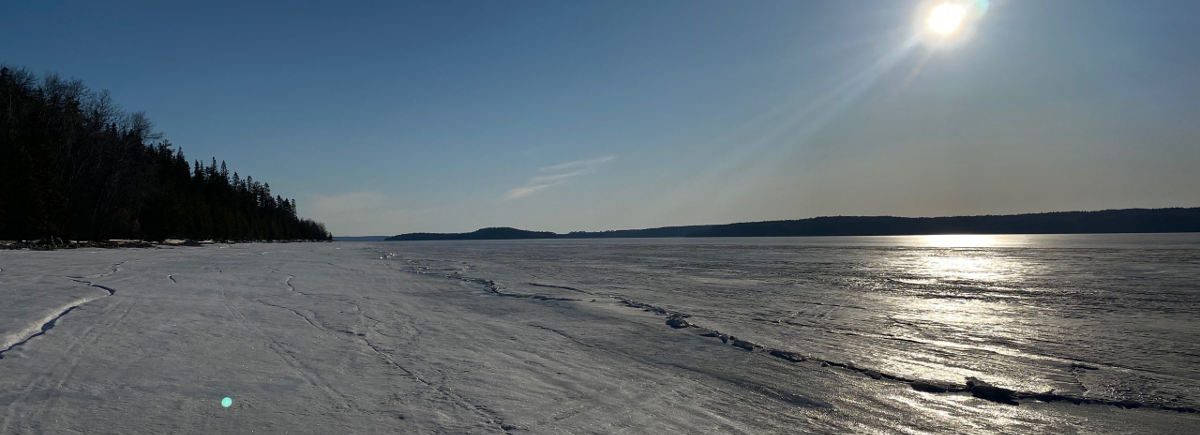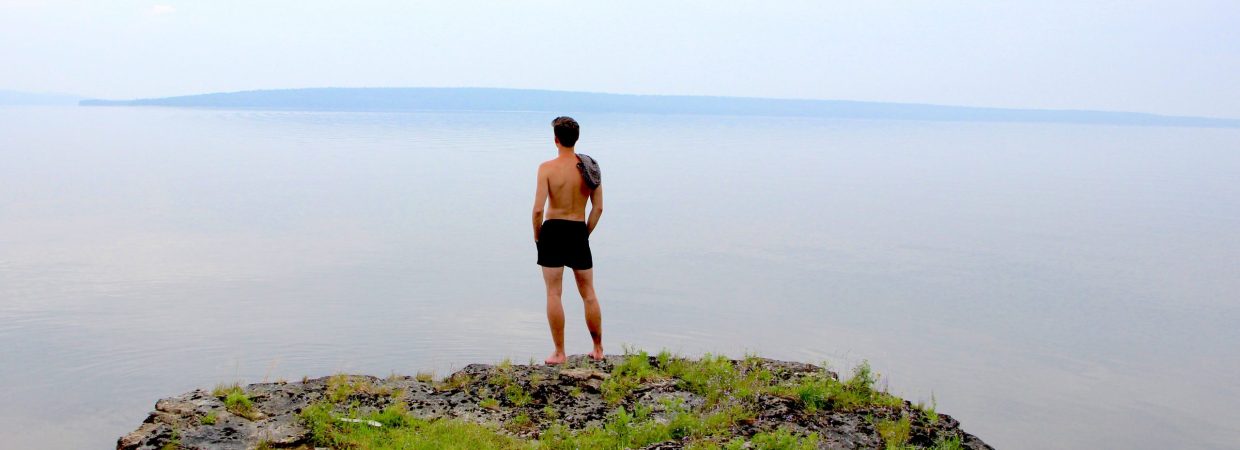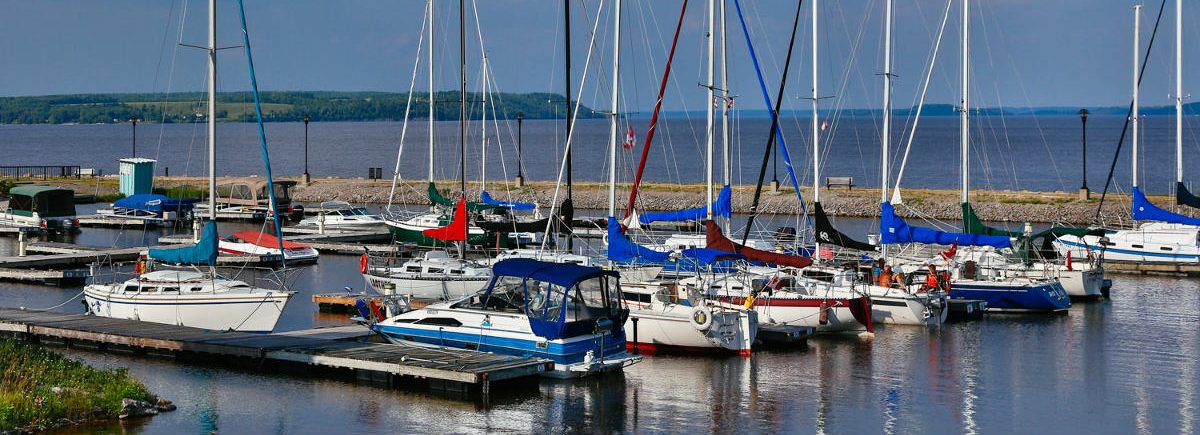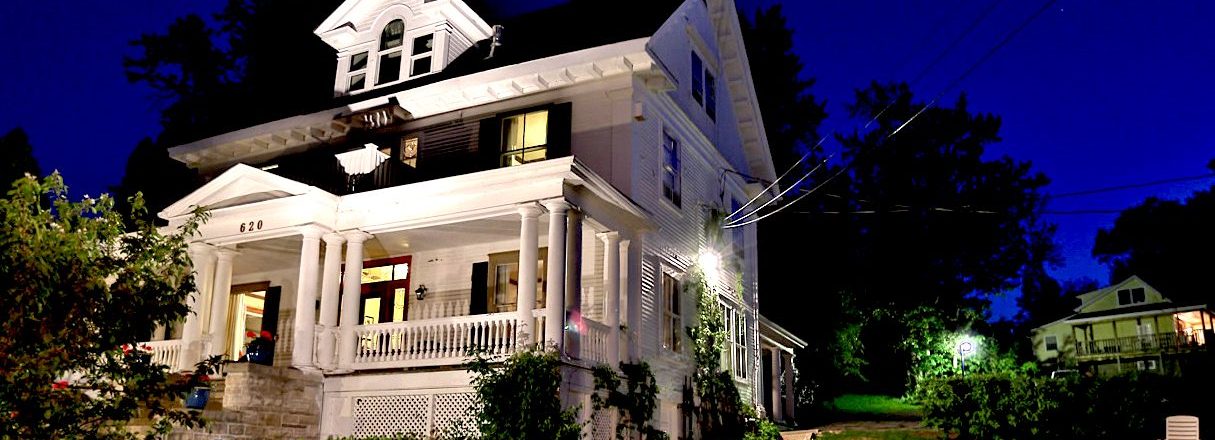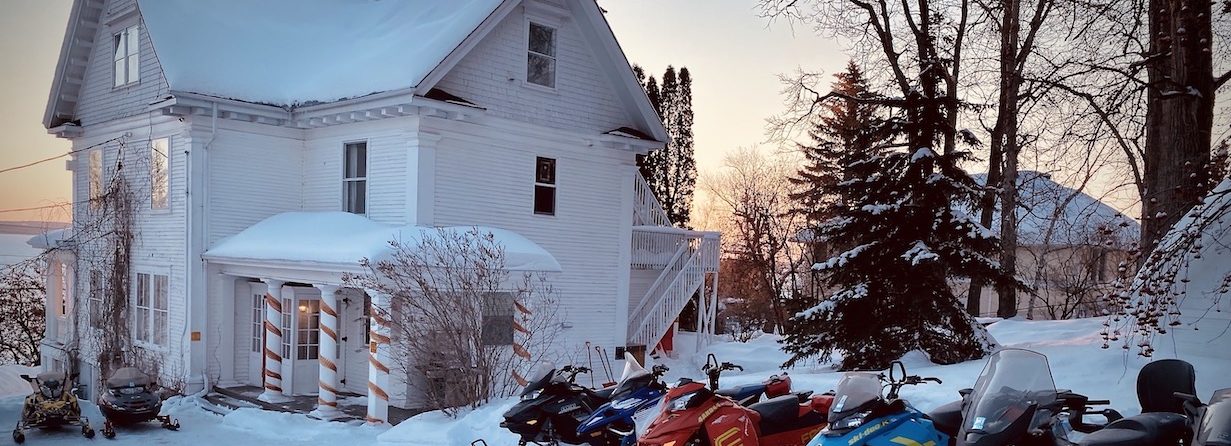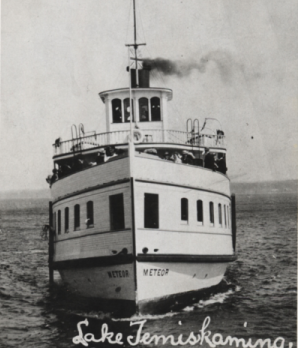
S.S. Meteor on Lake Temiskaming
The S.S. Meteor steamer played an important role in the development of the the Temiskaming region. The S.S. Meteor, was a passenger steamboat that operated on Lake Temiskaming during the late 1800’s and early 1900’s. The Meteor was an impressive machine, with a five-foot flywheel, electricity, running water, and a lounge on the second deck for music, cards, and an observation area. The Meteor was also the largest steamboat on Lake Temiskaming, and the only passenger steamer on the lake until 1899. It provided a vital lifeline to the outside world for people from the region; there was no train service or useable roads in the north until 1905. The Meteor served the communities on both sides of Lake Temiskaming for 40 years.
We will break down the Meteor’s history in the following sections written by author Douglas Baldwin.
Getting to Lake Temiskaming in 1886
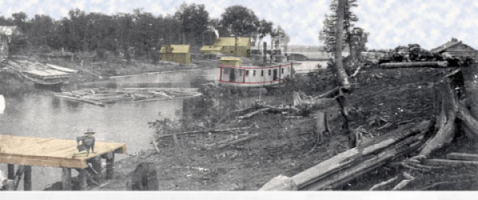 In the 1880s, the Ontario government sent out teams of land surveyors into northern Ontario hinterland to establish township boundaries in preparation for settlement. Given the primitive state of transportation, they often proceeded by foot, rail, and canoe.
In the 1880s, the Ontario government sent out teams of land surveyors into northern Ontario hinterland to establish township boundaries in preparation for settlement. Given the primitive state of transportation, they often proceeded by foot, rail, and canoe.
Alexander Herkes Telfer was a member of the Alexander Niven party which was responsible for establishing township boundaries on the west shore of Lake Temiskaming. Here follows a section of Telfer’s diary account of his experiences with this survey party in 1886.
Telfer left Toronto at 10:30 a.m. on 19 July 1886. The CPR train took him to Peterborough and then to Carleton Junction (Carleton Place) about 6 p.m. Telfer left by train for Mattawa the next morning at 1 a.m. arriving eight hours later. He spent the next eight hours procuring food and supplies before he and twelve other men (including three recently-hired French Canadians and one Aboriginal) left in “one large, strong boat and three birch bark canoes.” Telfer’s diary described the arduous nature of the trek to Lake Temiskaming:
July 21st: Started up the river, which is about a quarter of a mile wide, with steep banks from 250 to 300 ft. high…. The Ottawa would be a most magnificent public highway were it not for the many rapids, which seem to break the navigation. When we get to these rapids, if they are bad ones, we have to land, unload all our stuff and carry it past the rapids, then carry the canoes. In other places a rope is fastened to the bow of the canoe and from 3 to 5 men pull on the rope on shore, while one or two wade by the side of the boat and keep it out of the rocks and boulders till the rapid is passed. At other times, all hands have to plunge in to the water to their waist and pull on the ropes, stumbling over the large, slippery stones, where it would be almost impossible to stand without the rope: by that means, each man helps to hold up his companion.
Made 6 miles today….
July 23rd: … a team took us to the commencement of Lake Temiscamingue about 4 pm. The bark canoes were carried over the road; the last mile of that road beat all I ever saw – a wagon load drawn over large boulders, and so close together that the wheels rarely touched the ground. The Frenchmen took the large boat up the rappids [sic]; we then loaded up again. Just then, a steamboat came in sight with a raft of square timber in tow.”
Telfer later noted that the rate for freight per hundred pounds from Mattawa to the HBC fort on Lake Temiskaming was $1.00, and passenger fare was about $4.00, but he expected that competition the next summer would lower these rates.
Constructing the S.S. Meteor
The Meteor began life in 1886 as La Minerve. Local shipwright Charles Morin built the steamer near Long Sault (South Temiskaming) for the Temiskaming Colonization Society. The double-decker, square-sterned steamer had a steel-frame hull and was planked in tamarack that was cut along the Blanch River. It was 104.6 feet in length, had a beam of 23.8 feet, a gross tonnage of 111.5, a 100 hp engine, and could move at 10 to 13 mph. The boiler used cordwood.
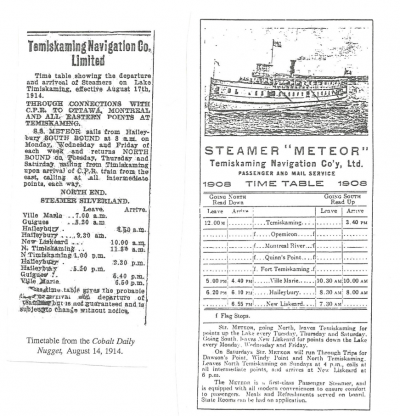 La Minerve was plagued with propeller problems and ran aground several times. When the steamer did so in front of Fort Temiskaming late in 1887 and damaged its propulsion plant the Temiskaming Colonization Society sold it to the Lumsden Steamboat Line. Lumsden towed the steamer to his shipyard at Opemican, rebuilt it, and renamed the steamer the S.S. Meteor. By July 1888 the new passenger vessel had a slimmer keel for greater speed, an open bow, a bank of cabins on the second deck, a round stern, measured 105 feet in length with a 23.8 beam, had a tonnage of 115.7, and was screw driven. It was licensed to carry 130 passengers. Note: the Opemican site is now part of a provincial park and the restauration of the site has was recently a major investment from the province of Quebec. You can learn more about the Opemican National Park by following this web link.
La Minerve was plagued with propeller problems and ran aground several times. When the steamer did so in front of Fort Temiskaming late in 1887 and damaged its propulsion plant the Temiskaming Colonization Society sold it to the Lumsden Steamboat Line. Lumsden towed the steamer to his shipyard at Opemican, rebuilt it, and renamed the steamer the S.S. Meteor. By July 1888 the new passenger vessel had a slimmer keel for greater speed, an open bow, a bank of cabins on the second deck, a round stern, measured 105 feet in length with a 23.8 beam, had a tonnage of 115.7, and was screw driven. It was licensed to carry 130 passengers. Note: the Opemican site is now part of a provincial park and the restauration of the site has was recently a major investment from the province of Quebec. You can learn more about the Opemican National Park by following this web link.
The Meteor underwent several modifications over the next 35 years. Between 1895 and 1897 the steamer was remodeled and enlarged at Opemican to accommodate the growing numbers of immigrants into the area. The steamer was lengthened by 25 feet (to 130.5), with a beam of 29 feet; had a tonnage of 203. 6; the new 165 hp engine could power the boat at speeds up to 18 mph; and could carry 305 passengers. Wood was still the preferred fuel. The remodeling enclosed the entire main deck and covered and enlarged the second deck. The bow provided plenty of room for storing baggage, freight, and livestock. Steam winches at the bow and stern could pull in the steel hawsers (thick cables) used to moor the steamer. Two rows of round-iron columns supported the upper deck. The Meteor was by far the most impressive steamer on the lake.
Historian Peter Fancy described the revamped Meteor: “Climb the main stairway to the new passenger deck. Elaborate paneling painted matte-white covers the entranceway walls. A long corridor with doors to cabins and washrooms stretches back towards the stern. Above runs a long skylight with narrow windows on the sides and shining brass light fixtures. Over the bulbs are milk glass tulip shaped shades. Two corridors, one on either side of the funnel trunk, lead forward into the main lounge. Here against the front edge of the funnel trunk rises a low platform stage with an upright piano. On both sides of the room and at the bow end run bench seats and backs. Along the top of the seatbacks, at neck level, is a continuous row of perforated openings for steam pipe heat and another sky light canopies the entire length. Electric candelabra hang from ceiling supports; smaller ones stud the white walls. Heavy canvas protects the polished hardwood floor. Grey-painted canvas covers the outside decks where passengers can lean against a varnished teak-wood railing.” The Meteor had a five-foot flywheel, starboard water pumps for toilets and bathrooms, electricity and running water. With a lounge on the second deck for music, cards, and an observation area, the Meteor was well-named the “Palace steamer.” The Meteor was the largest steamer on Lake Temiskaming.
The Meteor ’s Early History
The Lake Temiskaming Colonization Railway and its boats provided the first organized transport to and through the Lake Temiskaming district. A year after the CPR extended its tracks from Pembroke to Mattawa in 1881 the S.S. Mattawan became the first steamer to appear on Lake Temiskaming. The Colonization Railway brought the boat to Mattawa to transport people and supplies from Mattawa to the foot of Lake Temiskaming. The S.S. Argo arrived a year later. Although both boats ferried settlers, loggers, and freight, their primary role was the timber trade, moving large bodies of logs on slow-moving water bodies.
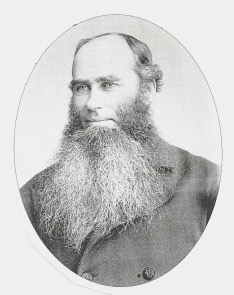 In the winter of 1886-7 the Société de Colonization du Lac Témiscamingue commissioned the building of a steamboat at Ville-Marie, and named it La Minerve in honour of the Montreal newspaper La Minerva which supported the patriots in the 1837-38 Rebellions and, more recently, praised the benefits of settling around Lake Temiskaming. Under Captain Morin in 1887, La Minerva serviced settlers between Gordon’s Landing (South Temiscamingue) and Baie des Peres (Ville-Marie) twice a week. Late that year the steamer ran aground near Fort Temiskaming and damaged its propulsion plant. Alex Lumsden subsequently bought La Minerve on 6 March 1888, towed it to his shipyard at Opemican for repairs and remodeling, and renamed it the S.S. Meteor. For the next eighteen years the Meteor was a key member of the Lumsden Steamboat Line.
In the winter of 1886-7 the Société de Colonization du Lac Témiscamingue commissioned the building of a steamboat at Ville-Marie, and named it La Minerve in honour of the Montreal newspaper La Minerva which supported the patriots in the 1837-38 Rebellions and, more recently, praised the benefits of settling around Lake Temiskaming. Under Captain Morin in 1887, La Minerva serviced settlers between Gordon’s Landing (South Temiscamingue) and Baie des Peres (Ville-Marie) twice a week. Late that year the steamer ran aground near Fort Temiskaming and damaged its propulsion plant. Alex Lumsden subsequently bought La Minerve on 6 March 1888, towed it to his shipyard at Opemican for repairs and remodeling, and renamed it the S.S. Meteor. For the next eighteen years the Meteor was a key member of the Lumsden Steamboat Line.
Alex Lumsden was a self-made man who began work as a mill hand in the Ottawa area in the 1850s before branching out on this own. By 1885 he headed the Lumsden Steamboat Line which owned the rights to tow logs from head of Lake Temiskaming to Ottawa. Soon, he owned a saw mill and shipyard at south end of Lake Temiskaming, timber limits on both sides of the lake, a large hotel, an electric company, and a bank. In 1898 he was elected to parliament as the MLA for Ottawa. With as many as sixteen steamers, Lumsden monopolized the passenger and freight business on Lake Temiskaming. When this millionaire died in 1904 at the age of 65, his death made the front page news in Ottawa and his funeral was attended by Prime Minister Wilfrid Laurier, the Mayor of Ottawa, and his fellow Ottawa lumber barons.
In 1888 Lumsden’s towing business was booming and he was looking for steamboats with more cargo space and greater towing capabilities. He thus purchased La Minerve — it had more passenger and cargo space than the Mattawan – which would also allow the company to use the Argo for full-time towing on Lake Temiskaming. As the number of settlers into the area increased the demand for the Meteor’s services, Lumsden bought the Temiskaming steamer in 1899. It took the same route as the Meteor, but on alternate days. Four years later the Jubilee joined them.
Following Alex Lumsden’s death, his widow Margaret and son John ran the company until 6 April 1906 when they sold the Meteor, Temiskaming, and City of Haileybury steamers to former employee Joseph Larochelle of Mattawa who formed the Temiskaming Navigation Company. The new company also owned the Jubilee, the Ville-Marie, as well as Lumsden’s wharves at New Liskeard, North and South Temiskaming, and Ville-Marie. Most of the company’s stock was held by prominent Mattawa businessmen, including Henry Timmins and his brother-in-law Arthur Ferland, and merchants in Ville-Marie.
Early Navigation Problems
The Mattawa-Ottawa river system was long a major north-south artery in central Canada. The area was first inhabited by Aboriginal Peoples who used the Mattawa River as a major transportation corridor. Early in the seventeenth century, French explorers Étienne Brûlé, Radisson, Des Groseilliers, La Vérendrye, and Samuel de Champlain canoed through the Mattawa area. Soon, both French and British fur traders employed this route either south from Hudson Bay or west from Quebec City. Since Lake Temiskaming was approximately halfway along the main canoe route between the St. Lawrence River and Hudson Bay, La Compagnie du Nord of French-Canadian merchants constructed a fort on the lake near the mouth of the Montreal River in 1679 to compete with the Hudson’s Bay Company posts to the north. Nine years later the Iroquois destroyed the fort and when the French re-established it in 1720 Fort Témiscamingue was constructed on the east side of the lake where the water narrows to 250 metres. This fort soon played an important strategic role in the struggle between France and Great Britain for control of the region’s fur trade. Following Great Britain’s conquest of New France the post was occupied by the North West Company (1788) and later by the Hudson’s Bay Company (1821). In 1837, the Hudson’s Bay Company opened Mattawa House, which became its most important trading post in the Ottawa Valley.
Located at the confluence of the Mattawa and Ottawa rivers, the village of Mattawa, which means “meeting of rivers” in Ashinabe, was at the crossroads between the Ottawa River and Lake Temiskaming. Travelers heading north towards Hudson Bay from Mattawa had to traverse a chain of lakes varying in length from 15 to 50 km and in width from 2 to 8 km, and separated from each other by rapids and waterfalls (a total drop of 17 metres), before reaching the village of Temiscaming at the south end of Lake Temiskaming.
Until near the end of the nineteenth century, water transport was virtually the only means to and from Lake Temiskaming, which at 108 km long and 9 km at its widest was, in reality, an enlargement of the Ottawa River. The first official French-Canadian settlers arrived at Baie des Peres (Ville-Marie) in 1882. They were aided by the Canadian Pacific Railway which had reached Mattawa the previous year. Three years later, Father Paradis helped to establish the Société de Colonization du Lac Temiscamingue to promote settlement in the area. To do so, it improved the portages around the rapids between Mattawa and the village of Temiscaming at the bottom of the lake and placed several small steamboats between the rapids. Not long afterwards, the La Compagnie de Chemin de fer de Témiscamingue (Temiskaming Colonization Railway) constructed several narrow gauge tramways around the rapids. This was done under the direction of the Oblate priests who hoped to attract French Canadians from Quebec and repatriate Franco-Americans by providing cheap land in the Temiskaming region.
Settlement, however, took second place to the logging industry. By the 1880s such timber barons as J.R. Booth, the Gillies Bros, and Alex Lumsden were harvesting large stands of white pine and towing the logs by steamboats to their sawmills. Mattawa was now the hub for both loggers and settlers. After the CPR branch line, the Temiskaming Colonization Railway, linked Mattawa with Temiscaming at the foot of Lake Temiskaming in 1894, passengers could leave Ottawa around midnight, arrive in Mattawa for breakfast, take the ferry across the Ottawa River, bypass 60 km miles of rapids and small lakes to the foot of the lake by rail, and then board the Meteor for Haileybury and New Liskeard.
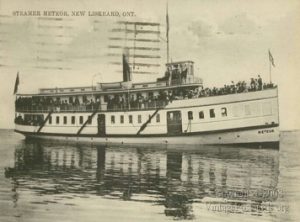 Mr. F. Kosmack, an early setter, offered this advice to prospective colonists:
Mr. F. Kosmack, an early setter, offered this advice to prospective colonists:
“The ‘Meteor’ is a large and commodious steamer. Settlers and their effects are landed wherever they desire. The distance from Temiskaming Station to Thornloe [New Liskeard] is about 70 miles. For the first 40 miles the lake is quite narrow and very deep, with an occasional bay. The shores continue rocky and picturesque — most beautiful from the tourist’s standpoint — most uninviting to the land-seeker. After that the lake becomes wider and shallower, the shores become lower, till at the northern end of the lake an enormous extent of fine level farming-land is reached.”
Until the Temiskaming and Northern Ontario Railway reached New Liskeard in 1905, the Meteor (and other steamboats) provided a necessary and vital link to the outside world.
The Meteor ’s Importance
According to one of the leading authorities on Lake Temiskaming steamships, Bruce W. Taylor, “To have come north on the Meteor, or even to have had an ancestor come up on that famous boat, is, for Northerners, akin to having an ancestor come over on the Mayflower. Even today, [1993] oldtimers talk with pride of having come up the lake from Témiscaming, on the Quebec side of the lake…. To have arrived by boat usually sets a person aside as a pioneer—one who arrived before the advent of the railway on the Ontario side in 1904.” In Quebec, he continued, the Meteor is the symbol of the Temiscamiens quebecois and is an important part of their heritage.
The Société de Colonization du Lac Témiscamingue commissioned the building of La Minerve (renamed Meteor) in 1887 to carry passengers and freight from Témiscaming to the north end of the lake. With no train service or useable roads into the north until 1905, this was the only way to the Little Clay Belt, and a slow, but steady trickle of settlers boarded La Minerve for points north. Steamship travel was not cheap. In 1894 it cost $4.50 to travel from Mattawa to Haileybury – which was equivalent to about two days pay for a labourer. Freight was an additional 85 cents per hundred pounds. The trip from Temiscaming to Ville-Marie was $1.00.
As the only passenger steamer on Lake Temiskaming until 1899, the Meteor provided a lifeline to the outside world for people on both sides of the lake. It ferried settlers and their belongings to their new homes; delivered the mail; carried freight, prospectors, hunters and fishermen, and tourists to the area; and allowed farmers and merchants to take their goods to market. William G. Trethewey was only one of many prospectors who found his way to the silver fields of Cobalt via the Meteor. After traveling from British Columbia to Toronto in April 1904 he purchased a prospector’s license and equipment, and when the lakes were clear of ice, left by train for Temiskaming in May. He stayed the first night in North Bay before boarding the CPR to Mattawa and later the Meteor to Haileybury — a “hamlet of a few houses, a store, a post office, and one hotel…. In spite of the electric lights of the town not being in commission, I managed to find a place to sleep, thanks partly to Mr. McKinley [whom he had met on the Meteor].” An eight kilometre walk over a muddy spring trail brought the thirty-seven-year old to the Cobalt camp.
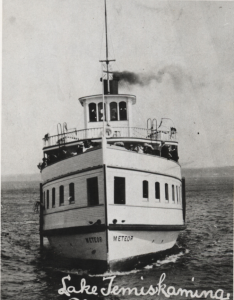 On a typical trip, the Meteor left Témiscaming in the late afternoon on Mondays, Wednesday, and Fridays following the arrival of the train. After stopping at several small settlements along the way, the steamer reached Ville-Marie around sundown. The next morning it left early for Haileybury, New Liskeard, and North Temiskaming before returning to Ville-Marie for the night. The following day the Meteor returned to the foot of the lake to begin again. Except for special excursions, the steamer did not operate on Sundays. The advertisements provide a more detailed look at the Meteor’s time table.
On a typical trip, the Meteor left Témiscaming in the late afternoon on Mondays, Wednesday, and Fridays following the arrival of the train. After stopping at several small settlements along the way, the steamer reached Ville-Marie around sundown. The next morning it left early for Haileybury, New Liskeard, and North Temiskaming before returning to Ville-Marie for the night. The following day the Meteor returned to the foot of the lake to begin again. Except for special excursions, the steamer did not operate on Sundays. The advertisements provide a more detailed look at the Meteor’s time table.
The Meteor was also a source of entertainment for the communities surrounding Lake Temiskaming. “If anything,” wrote historian Richard Tatley, “the Meteor was probably unsurpassed as a recreation ship in Timiskaming.” A variety of social groups rented the Meteor for dances, excursions, and the occasional church service. In July 1908, for example, the Anglican congregations in New Liskeard, Haileybury, and Cobalt chartered the Meteor for an excursion on Lake Temiskaming. Approximately five-hundred Anglicans set out for a day of children’s races, picturesque walks, and games of cricket and soccer. The previous year, the Presbyterian Church, the Haileybury Yacht Club, the Methodist Church, the St. Jean Baptiste Society of Ville-Marie, and the Oddfellows were just a few of the groups that booked the Meteor for excursions. The steamship line placed advertisements in the local newspapers emphasizing the many attractions of a lake cruise – a visit to the old Mission; a run up the Montreal River; the scenic views, including the precipitous 61 metre high Devil’s Rock; the dramatic views and vistas; and a moonlight cruise complete with a meal and dancing under the stars to a live orchestra. The mine manager of the Kerr Mining Company, Robert Livermore, wrote that one his family’s favourite summer pastimes was a cruise aboard the Meteor on Lake Temiskaming, followed by a swim.
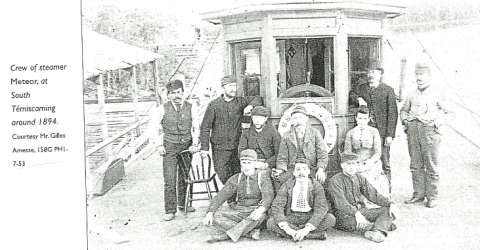 Here are some captains of the S.S. Meteor
Here are some captains of the S.S. Meteor
1887: Charles Morin
1897-1904: John Patrick Redmond, Jr.
1906: Albert Gaul
1913-1923: McCarthy Burns
Travelling on the Meteor in 1890
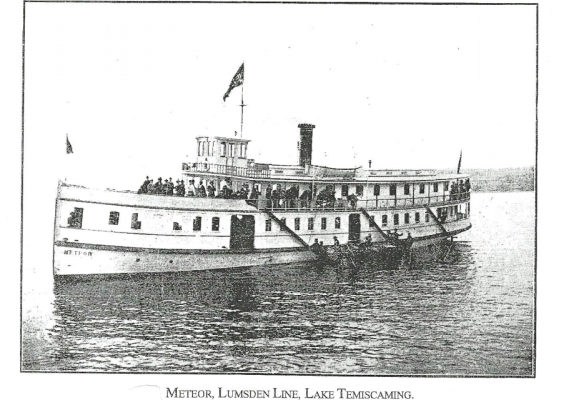
The following account in the The Algoma Missionary News describes the Anglican Bishop’s visit to Lake Temiskaming in December 1890:
On the 16th September, 1890, the Bishop arrived at North Bay by the C.P.R., en route for Lake Temiscamingue, and took on board the Chaplain. They travelled along by rail as far at Mattawa, where they alighted, and went to the house of the Rev. Robert W. Samwell ….The following day they continued their journey up the Ottawa River. The first stage was by small steamboat with a scow attached to its side; and then when rapids stopped navigation, the boats were left behind, and all proceeded to portage in the easiest manner by means of a narrow-gauge one-horse tramway, the little rails of which were brought even with similar rails on board the scow by a little draw-bridge dock, and the flat-car with the baggage on the scow was drawn off by the horse, and on to the tramway. This tramway was built by the side of the rapids until navigation again opened, when another little steamboat with scow was in waiting to receive in similar manner the passengers and baggage-car. From Mattawa to the Long Sault at foot of Lake Temiscamingue is about forty miles, which composed the day’s journey, and in that distance they made portages in the manner described, four times. The last portage, however, some six miles, differed from the others in that, instead of the horse, there were a little locomotive engine and two covered cars. Arrived at the head of the Long Sault and at Gordon Creek, they put up in the French [Canadian] boarding-house, and there awaited the return of the steamer Meteor, Captain Percy, which plies upon Lake Temiscamingue. To their great chagrin they found that she would not start up the lake until the day after the morrow…. It is to be feared that the Bishop, when he did retire, must have slept very badly that night, for from the bar-room right underneath ascended the noise and the horrible words, in the French language, common to drinking saloons, and suggestive only of darkness and eternal ruin… The next day, Thursday, they looked around at the beautiful scenery of the Long Sault and Gordon Creek, and thought of going to see the Kippewa also, some nine miles away, but decided there was grand scenery enough on the Ottawa and Temiscamingue for one trip…. The next morning they started on the good steamer Meteor to ascend Lake Temiscamingue. For many and many a mile it was narrow, and with banks rising abruptly and high. The Chaplain remarked that it was like some grand and beautiful river, perhaps the Rhine.…
Just after dinner they arrived at the Hudson Bay Fort, but did not land or remain more than a few minutes. The Chaplain pointed out the buildings of the company at the Fort, and on the hill over it the picturesque little cemetery, where lie the remains of Father Laverlocher; and on the opposite side (Ontario), of the narrow channel, the now deserted Roman Catholic Indian Mission Station, with its neat wooden church, priest’s house, hospital and nunnery, all empty, decaying, and silent. About three miles further up they arrived at Priests’ Bay, where the Roman Catholic Church has a fine establishment, church, priest’s house, convent, and hospital, all of red brick, and agent’s house of stone, while stretching back for some miles in the Province of Quebec, there is a good well-to-do settlement of French Canadians. Here they parted from the Grey nuns with much regret, who were arrived at their journey’s end. They then proceeded further up the lake, keeping on the Quebec side until they came to the silver mine, which is just on the shore, and now being fully worked. The Bishop and Chaplain landed, and the superintendent showed them all over the works and explained the process throughout. The Meteor then crossed the lake diagonally at its widest part to the Ontario shore, and landed the Bishop and Chaplain at Haileybury, the farm and home of Mr. Farr and his family. This was the goal of their journeying so far, and here they met Mr. Marsh, of Wycliffe College, who had been laboring on the lake for several weeks before, in most earnest and arduous mission work. He made Haileybury a centre, and from thence visited the numerous families, a great many of them belonging to the Church who had taken up farms on the Ontario shore….
That night the Bishop slept at Haileybury, while Mr. Marsh took the poor Chaplain in a little birch-bark canoe along the shore in the dark to Mr. Lawler’s house, where they slept. These canoes are very easily upset, and so true to the Bishop’s definition of their danger, for his Lordship remarked that a man must have his hair pretty evenly parted in the middle, or it would be enough to overbalance one of them. The next day, Saturday, the Bishop stayed at Haileybury, the guest of Mr. and Mrs. Farr, and all hands had a quiet restful time. In the afternoon Mr. Marsh and the Bishop manned the canoe, the former paddling in the stern, and his Lordship paddling in the bow, and they paid the Lawlers a visit to their great satisfaction. …
Then after dinner the Bishop bade good-bye to all, and proceeded on up the lake in Mr. Farr’s large sailing-boat, the little canoe towed behind. The Bishop held the helm, Mr. Marsh managed the sails, and the Chaplain helped a bit in the bow, and looked gloomy and miserable, until rallied by his Lordship and made all smiles once more.…
[After several days visiting the widespread congregation by bush trails and canoes they] all proceeded once more to board the Meteor for the return voyage. The first night they stayed at Priests’ Bay, arriving about dark, and remaining there for the night, and all sleeping on board. That night they held a service in the state-room of the Meteor…
The next morning the Bishop complained that his bed, or rather bunk, was as hard as the soft side of a plank, and for him very little sleep in consequence. They then went on to the Hudson Bay Fort, landing then and looking through the buildings and store; and inspected the colossal canoe and a young moose. This creature had been ill with a cold, and looked truly miserable, poised upon its four long legs, and with its heavy head and Roman nose, and the most woe-begone expression of face and bearing. They then steamed down the lake to the head of the Long Sault again, but not to the French boarding-house, as all hands slept on the Meteor. But here also the Bishop held a service on board, which was well attended, Captain Jones, of the steamboat Argus, and his crew, being also present; and surely the poor people there seldom get such a treat and spiritual happiness….
The next day, Wednesday, they returned in same order, tramway and steamboats, down the Ottawa to Mattawa and again enjoyed there the hospitality of the mission house. They then set out to the railway station, the Bishop for Sault Ste. Marie, the Professor for Lindsay, and the Chaplain for North Bay.
The Final Years
In 1910, the Temiskaming Navigation Company operated seven or eight steamers on Lake Temiskaming; two years later, however, the company’s revenues had declined so much due to competition from more efficient transportation methods that it had to take out a $13,000 mortgage on the Meteor and the Temiskaming. The following year the head office returned to Temiscaming from Haileybury and cost cutting continued as railways assumed most of the steamers’ transportation role. Since the completion of the Temiskaming & Northern Ontario Railway to New Liskeard in 1905, and its connection to the National Transcontinental Railway at Cochrane three years later, steamers were no longer needed to take freight and passengers from Mattawa to the Ontario side of Lake Temiskaming. In addition, the completion of the Nipissing Central Railway Company’s streetcar line in 1911 provided passenger service between Cobalt, Haileybury, and New Liskeard every 30 minutes. At approximately the same time, Cobalt, New Liskeard, Haileybury and the townships of Bucke, Dymond and Coleman petitioned the Mininster of Public Works for a macadam road between Cobalt and New Liskeard – and about 16 kilometres were macadamized in 1912, allowing greater truck access. That same year, a railway spur line linked the T&NO Railway with the Haileybury wharf.
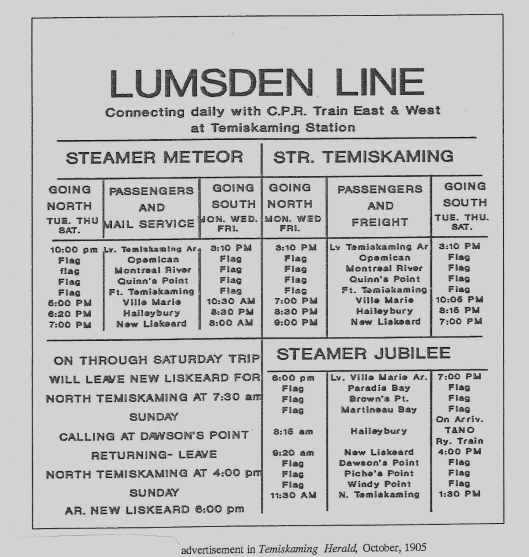
The First World War further dampened enthusiasm for pleasure excursions and by 1915 the only passenger steamers left on the lake were the Meteor and the Silverland. In the spring of 1917 Temiskaming Navigation Company surrendered its charter and sold the Meteor, the Temiskaming and Silverland to Télésphore Simard, a Quebec MP and mayor of Ville-Marie, who represented a Ville-Marie syndicate.
As rail transport had not reached the Quebec side of Lake Temiskaming, lake steamers remained the region’s life line to the outside world and the Meteor and the Temiskamingthus continued transporting freight and passengers to and from the east side of the lake for La Compagnie de Navigation Ville-Marie. For another six years Captain McCarthy Burns skippered the Meteor about Lake Temiskaming, alternating with the Temiskaming three times weekly. Unfortunately, the Meteor was at the opposite side of the lake when the great fire of 1922 destroyed Haileybury.
The Canadian Pacific Railway’s decision to link Temiscaming with Ville-Marie by rail spelled the end of the Meteor’s usefulness, and the steamer made its last run in 1923. Late in November 1926 the Meteor caught fire as it was being towed to Ville-Marie for the winter. She burned for 24 hours or so while crowds watched from the waterfronts at Haileybury and New Liskeard. Cut adrift, the Meteor went aground near the Old Mission, and lay on the gravel bottom over the winter. Subsequently, the steamship was savaged for its wood and steel strips until only the hulk remained. When she became a hazard, the Upper Ottawa Improvement Company dynamited the steamer’s remains in June 1928. After 37 years of serving the communities on both sides of Lake Temiskaming, the S.S. Meteor was no more.
About Douglas Baldwin
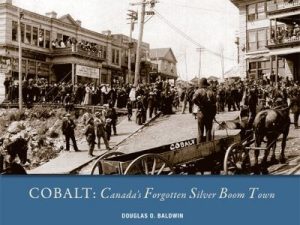 Douglas Baldwin is the author of over 40 books and dozens of articles on Canadian history; he is a retired professor of history from Acadia University and now lives in Toronto. His interest in Cobalt began in 1975 and he has since written numerous papers on the story of Cobalt. His most recent book, Cobalt: Canada’s Forgotten Silver Boom Town is a comprehensive history of Cobalt and hard rock mining in northern Ontario.
Douglas Baldwin is the author of over 40 books and dozens of articles on Canadian history; he is a retired professor of history from Acadia University and now lives in Toronto. His interest in Cobalt began in 1975 and he has since written numerous papers on the story of Cobalt. His most recent book, Cobalt: Canada’s Forgotten Silver Boom Town is a comprehensive history of Cobalt and hard rock mining in northern Ontario.
A few of his publications are: Abegweit: Land of the Red Soil, The Charlottetown Conference, Prince Edward Island: An Illustrated History, The Life of Nurse Mona Gordon Wilson.
____________________________
You can learn on other topics
Culture & History / Events & Festivals / Nature & Outdoors
Special People & Places / Wellness Healthy Living
at Destination Temiskaming Blog



